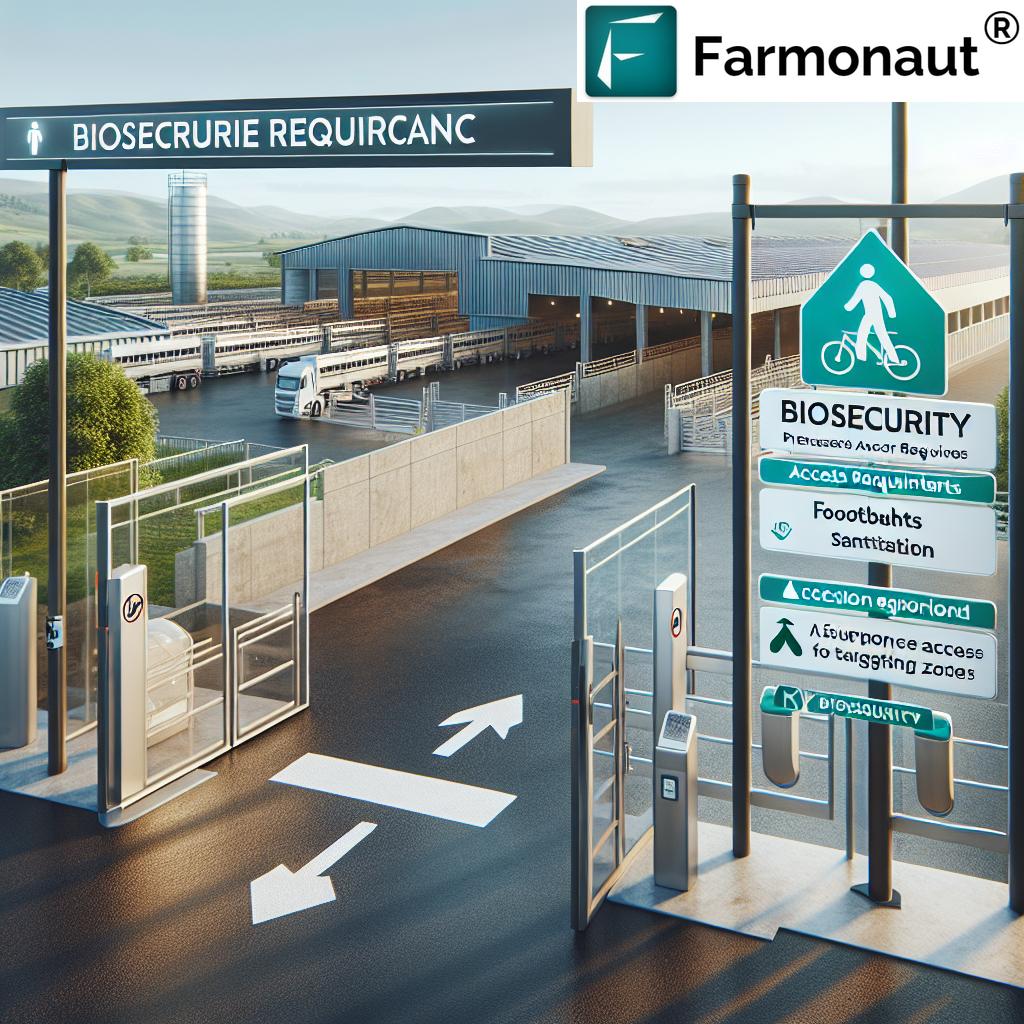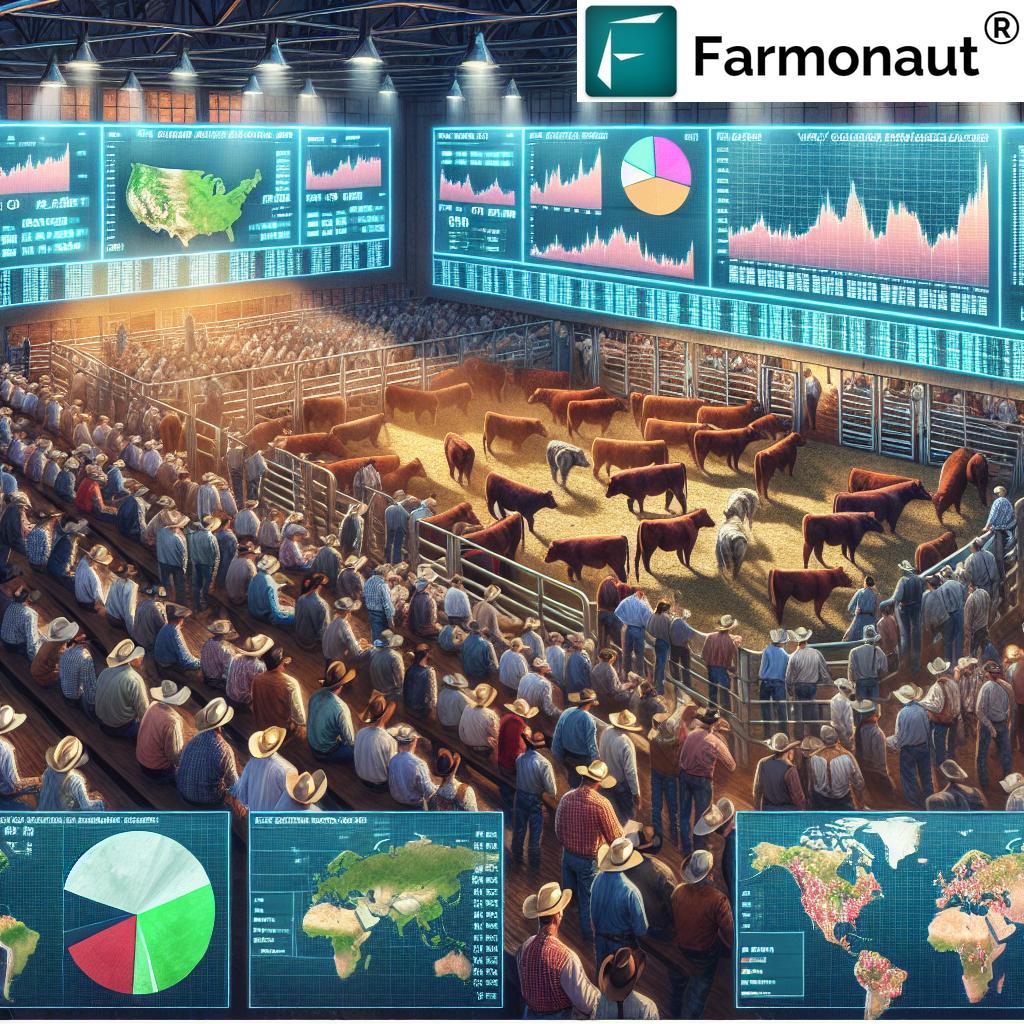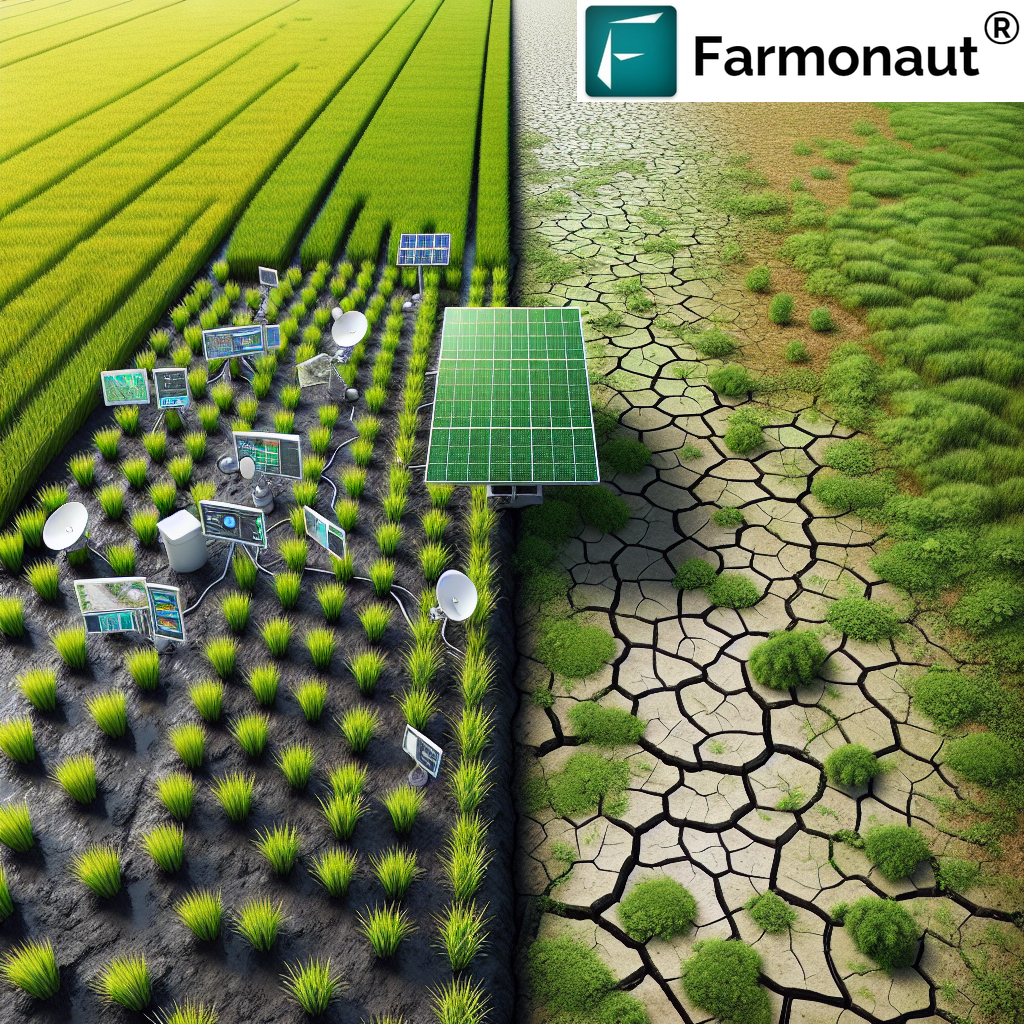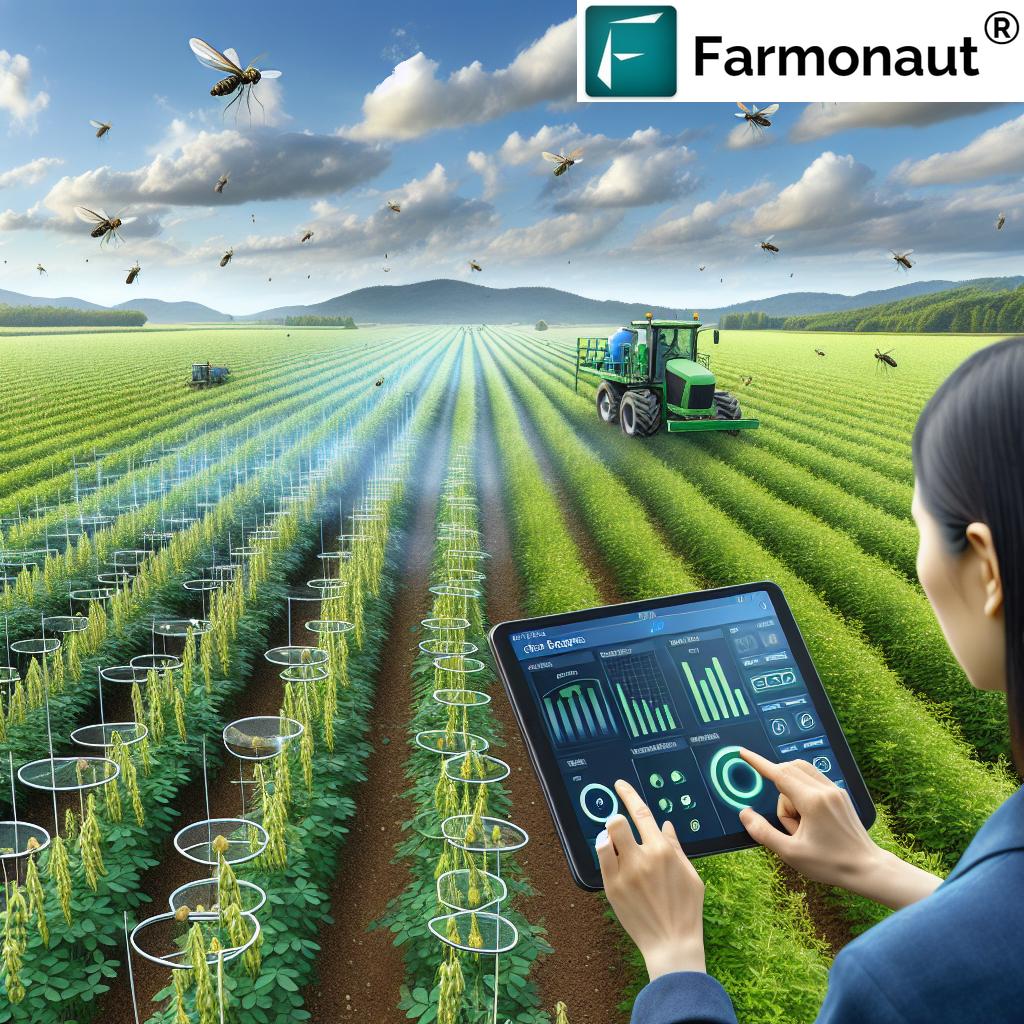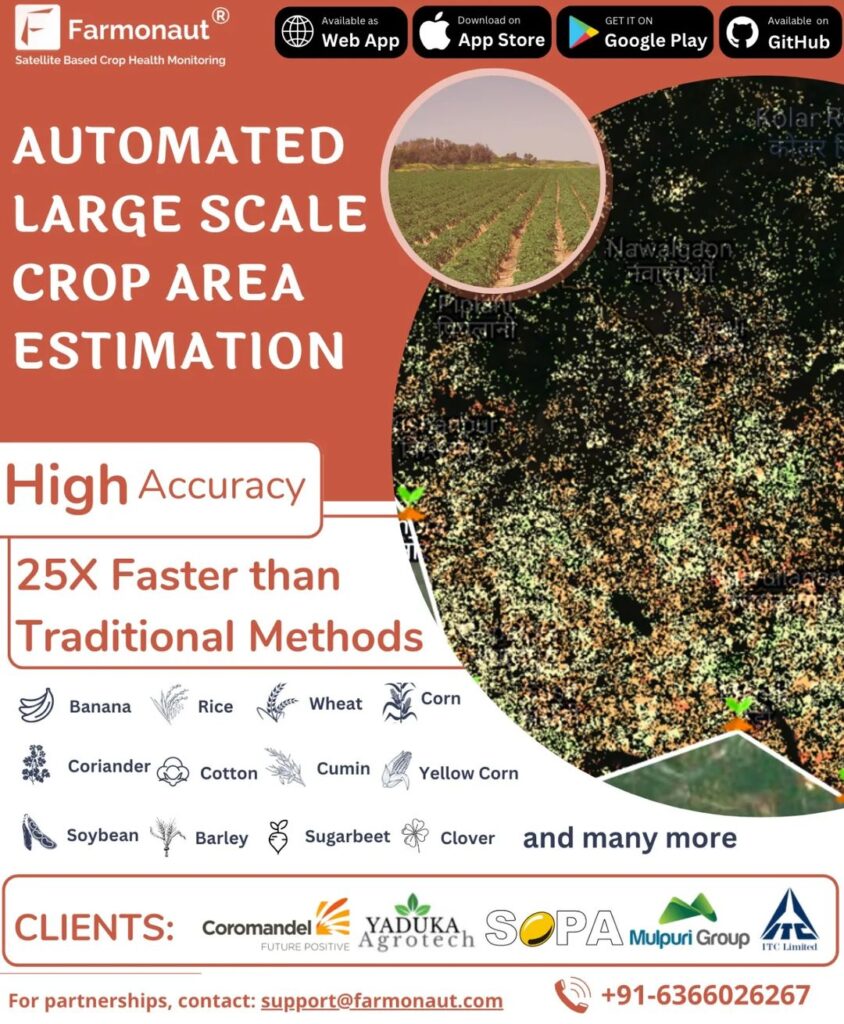Farm Biosecurity: 7 Shocking Hacks to Stop Pests Now!
“Over 40% of global crop losses are caused by pests and diseases, making biosecurity a top farming priority.”
- What is Farm Biosecurity?
- Why Biosecurity Matters in Modern Agriculture
- Farm Biosecurity: 7 Shocking Hacks to Stop Pests Now!
- Comparative Biosecurity Practices & Impact Table
- Technology & Innovation in Biosecurity Management
- Developing a Farm Biosecurity Plan
- How Farmonaut Empowers Biosecurity
- FAQ: Farm Biosecurity
- Conclusion and Next Steps
Farm biosecurity practices form the backbone of every resilient, sustainable, and profitable agricultural enterprise. At Farmonaut, we are passionate about integrating technology & innovation into daily farm management to help prevent the spread of pests, diseases, and weeds.
With agriculture and forestry facing increasing vulnerabilities—such as climate change, intensified trade, and emerging pathogens—the need to implement robust biosecurity measures for farms has never been greater. Through effective planning and state-of-the-art solutions, we can safeguard the health of our crops, livestock, property, and the broader environment.
What is Farm Biosecurity?
Biosecurity refers to collective management practices, policies, and technologies designed to prevent the introduction and spread of harmful organisms: from animal and plant diseases to invasive weeds and pests across agricultural and forestry operations. The focus is on keeping our farm, livestock, equipment, facilities, and environment safe and clean, minimizing risks, and supporting sustainable and profitable farming for the future.
Whether dealing with crops, animals, or mixed operations, farm biosecurity is essential for:
- Preventing contamination and infection on agricultural and forestry properties
- Reducing economic loss from pest and disease outbreaks
- Maintaining product quality and safety for end consumers
- Supporting bio-diversity and the natural environment
Why Biosecurity Matters in Modern Agriculture
Uncontrolled introduction and spread of pests, weeds, and diseases can devastate farm production systems. Losses not only damage yields and livestock health but can also threaten the economic stability of entire regions.
Modern agricultural biosecurity management isn’t just best practice—it is now a necessity for:
- Keeping our operations resilient against evolving threats
- Ensuring food security globally
- Meeting strict export/import requirements
- Minimizing reliance on chemical controls through prevention-first approaches
By implementing these biosecurity hacks and measures, farms can enhance productivity, compliance, and profitability.



Farm Biosecurity: 7 Shocking Hacks to Stop Pests Now!
Let’s dive into the actionable, science-backed practices every farm, field, or forest operation should use immediately.
1. Access Control and Visitor Management: Your First Biosecurity Barrier
Limiting access and monitoring who’s on your property is the first and one of the most critical farm biosecurity practices to preventing spread of pests and diseases.
- Install clear signage: Notify all entrants about your farm’s biosecurity requirements and protocols.
- Designated parking zones: Establish parking areas away from crops and livestock
- Vehicle management: Use vehicle wash-down and disinfection points for all entering and exiting vehicles
- Visitor logs and inductions: Keep records of visitors and provide biosecurity briefings
By controlling access and tracking movement, we reduce the risk of outside contamination and establish a protective barrier around critical operations.
Tip: Use Farmonaut’s Fleet and Resource Management tools to efficiently monitor vehicle movements, optimize logistics, and ensure compliance with biosecurity entry protocols.
2. Sanitation and Hygiene Practices: Keeping Equipment and Facilities Clean
Strict cleaning and disinfection of all farm equipment, machinery, and tools is essential in fighting the spread of pathogens.
- Regular equipment cleaning: Schedule and document all cleaning for tractors, combines, vehicles, and implements.
- Dedicated clean-down areas: Create spaces for cleaning machinery between paddocks to stop cross-contamination.
- Segregated tools for high-risk areas: Use separate sets for quarantine, isolation pens, or sick animals.
- “Come clean, go clean” policy: All personnel and equipment must arrive and leave decontaminated.
Farm sanitation and hygiene protocols are key in both animal and crop operations—reducing contamination, preventing disease transmission, and protecting our farm’s ongoing productivity.
Pro tip: Leverage Farmonaut’s large scale farm management solutions for real-time monitoring and logging of sanitation schedules and cleaning compliance across multiple facilities or fields.
“Implementing 7 key biosecurity hacks can reduce pest-related losses by up to 60% on innovative farms.”
3. Quarantine and Isolation Procedures: Stop New Threats in Their Tracks
One of the most effective steps for preventing the introduction and spread of diseases is the rigorous use of quarantine procedures for livestock and crops.
- Isolating new animals: Hold new or recently arrived stock in quarantine pens before introducing to main herds
- Separate maternity and sick animal pens: Limit risk of spread from vulnerable or unhealthy animals
- Plant isolation: Set aside areas for newly delivered or suspect crop batches
- Disposal of dead or sick animals: Use designated areas with biosecure disposal methods
- Strict staff protocols: Equip personnel with designated protective gear and training before entering quarantine zones
Quarantine and isolation pens ensure the main farm population remains protected while new arrivals are monitored for signs of disease or pests.
4. Pest and Weed Management in Agriculture: Early Detection, Lasting Control
A robust pest and weed management program is vital for preventing infestations and limiting spread of weeds, pests, and diseases.
- Active monitoring: Use regular field and livestock inspections to identify common and emerging pest or disease symptoms
- Record keeping: Document all monitoring results, issues identified, and treatment actions
- Awareness and training: Ensure staff are trained to spot unusual symptoms or weed species
- Consult neighbours: Share information and coordinate responses where issues cross boundaries
With frequent monitoring, accurate identification, and timely reporting, pest issues can be tackled before they become major problems.
Did you know? Farmonaut’s satellite-based crop health monitoring uses remote sensing to detect early signs of pest outbreaks, soil health problems, or stress areas—helping us make faster, smarter management decisions.
5. Water and Feed Management: Block Contamination Pathways
Protecting and monitoring resources like water and feed is vital for animal and crop health.
- Inspecting water sources: Ensure clean irrigation systems and drinking troughs
- Secure feed storage: Store in clean, dry, pathogen-free areas with good pest control
- Check supplier integrity: Source all feed and seed from trusted, certified suppliers who maintain their own biosecurity
- Regular testing: Test for pathogens or toxins in water and feed materials, particularly after floods or contamination episodes
Through rigorous resource management and a zero-tolerance approach to contamination, we further shield livestock and crops from infectious threats.
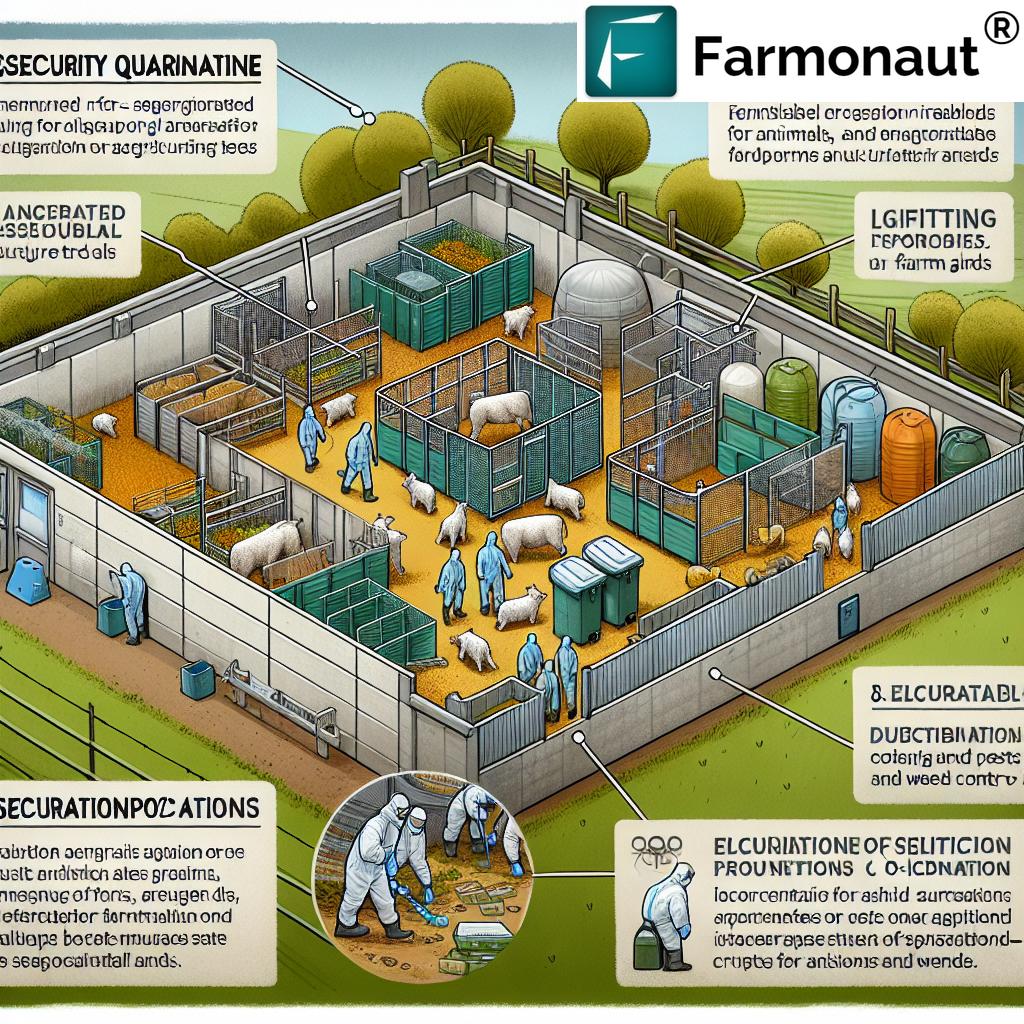
6. Farm Waste Management Best Practices: Eliminate a Hidden Threat
Improper waste management can be a major source of disease, pests, and weed spread.
- Disposal area planning: Position waste sites and carcass disposal zones well away from water sources and livestock/crop zones
- Segregate and contain: Use dedicated bins, skips, or fenced spaces for animal, plant, and chemical waste
- Environmental controls: Install spill containment, drainage controls, and covers to minimize contamination
- Monitor and document disposal: Track the amount, type, and disposal method for all waste streams
By implementing farm waste management best practices, we not only reduce biosecurity risks but also meet environmental, public safety, and regulatory requirements.
7. Biosecurity Training for Farm Workers: Your Human Biosecurity Shield
All our biosecurity protocols are only as effective as the awareness and training of our workers.
- Regular training sessions: Educate all staff on hygiene, animal handling, and emerging pest risks
- Designate biosecurity officers: Appoint champions responsible for compliance
- Protocols and documentation: Provide clear, written SOPs for critical procedures
- Continuous improvement: Seek regular feedback and update training materials
Through ongoing education and designated responsibilities, we strengthen the entire farm’s response to biosecurity threats.
Bonus: Record-Keeping – Document Every Biosecurity Action
Transparent, detailed record-keeping is the backbone of effective agricultural biosecurity management—allowing us to track, evaluate, and improve every hack above.
- Maintain digital/physical logs of cleaning schedules, health checks, monitoring data, and visitor registers
- Document all waste disposal, feed/water tests, and staff training dates
- Ensure records are accessible for audits and quick reference
Better records mean better prevention, faster outbreak containment, and easier communication of biosecurity status both within operations and for regulatory purposes.
Comparative Biosecurity Practices & Impact Table
| Biosecurity Hack | Estimated Effectiveness (% Pest Reduction) | Implementation Time (Days) | Estimated Cost ($) | Tech Innovation Level |
|---|---|---|---|---|
| Access Control & Visitor Management | 50–70% | 2–7 | 200–1,500 | Modern |
| Sanitation & Hygiene Practices | 40–60% | 1–14 | 300–2,000 | Traditional – Modern |
| Quarantine & Isolation Procedures | 60–80% | 1–21 | 250–3,500 | Traditional – Modern |
| Pest & Weed Management | 35–75% | 2–21 | 300–3,000 | Modern – Cutting-edge |
| Water & Feed Management | 40–55% | 1–10 | 150–1,500 | Modern |
| Waste Management | 30–65% | 2–14 | 250–2,000 | Traditional – Modern |
| Employee Training & Awareness | 45–70% | 3–30 | 400–2,500 | Modern |
Technology & Innovation in Biosecurity Management
In the era of precision agriculture, leveraging technology is vital to maximizing our biosecurity measures and pest and disease management. Here’s how tech advancements are transforming agricultural biosecurity management:
-
Satellite Remote Sensing & AI: Farmonaut’s platform combines multispectral imaging and AI to monitor vegetation health, soil moisture, and even weed or pest outbreaks across vast areas, informing rapid response and preventive action.
See how this technology empowers Africa and Asia farmers:
- Blockchain-based Traceability: Tech like Farmonaut’s Product Traceability ensures
transparent supply chains from farm to consumer, reducing fraud and facilitating rapid recall in case of biosecurity breaches. - Data-driven Advisory: The Jeevn AI Advisory System offers personalized, real-time insights on farm management, weather patterns, and biosecurity best practices.
- Fleet Tracking & Resource Management: Fleet management features optimize vehicle movements and help comply with biosecure access protocols, reducing accidental contamination risks.
- Carbon Footprinting: Farmonaut Carbon Footprinting allows us to monitor, report, and minimize farm emissions, aligning environmental sustainability with biosecurity.
Integrating technology turbocharges every aspect of our biosecurity plan—from detection and monitoring to documentation and compliance.
Developing a Farm Biosecurity Plan: From Prevention to Action
A clear, actionable, and regularly updated farm biosecurity plan is essential for organizing, executing, and communicating all practices and protocols described above.
Key Components to Include:
- Responsibilities: Define who oversees which biosecurity areas or procedures
- Status of livestock, feed, and water: Document sources and biosecurity checks
- Access, vehicle, and equipment control: Map out procedures for entry, cleaning, and maintenance
- Production practices: Detail hygiene, quarantine, pest, and weed monitoring measures
- Outgoing products and inputs: Specify documentation and traceability requirements
- Emergency protocols: Include rapid response steps for disease or pest outbreaks
- Record-keeping and review: Schedule regular audits and improvements
A well-developed plan is our farm’s blueprint for ongoing biosecurity success.
Scale with confidence: If you’re a large-scale grower or agri-business, the Crop Loan and Insurance Verification Solution from Farmonaut combines satellite verification to support financial decision-making and crop loss reporting—essential for sustainable risk management and compliance.
Explore end-to-end large scale farm management platforms to digitize, organize, and secure your biosecurity strategy, no matter how complex the operation.
How Farmonaut Empowers Biosecurity
Farmonaut is revolutionizing farm biosecurity worldwide with its cost-effective, scalable, and accessible suite of management technologies, tailored for every user—from small farms to large agribusinesses, forestry operations, and government agencies.
Why Choose Farmonaut for Biosecurity Enhancements?
- Real-Time Crop Health Monitoring: Instantly detect stress, disease, pest outbreaks, and abnormal variations at field, crop, or regional level with satellite NDVI analytics and AI-driven mapping.
- Comprehensive Data Integration: Farmonaut brings together weather, soil, pest surveillance, and management scheduling in one easy-to-use dashboard—boosting compliance and efficiency.
- Traceability & Supply Chain Integration: For maximum transparency, Farmonaut’s blockchain-based traceability delivers complete visibility and helps keep biohazards out of your value chain.
- Affordable Sustainability Solutions: Integrated carbon tracking and compliance reporting makes it easy for even small operations to implement eco-friendly and biosecure policies.
- API Integration: Enhance your own systems with Farmonaut API access (developer documentation) to automate monitoring, record-keeping, and incident alerts.
Farmonaut stands out by removing the cost and complexity barriers associated with traditional precision tools—delivering advanced biosecurity and management at your fingertips.



FAQ: Farm Biosecurity
Q1: What is farm biosecurity and why is it essential?
Biosecurity is the set of management practices that prevent the introduction and spread of pests, diseases, and weeds on agricultural and forestry properties. It protects the health and productivity of crops, livestock, and the wider environment—ensuring both profitability and food safety.
Q2: What are the biggest biosecurity threats to farms?
Major threats include animal and plant pathogens (e.g., viruses, fungi, bacteria), invasive pests (like insects and nematodes), noxious weeds, and contamination from waste, water, or feed. Emerging diseases or changes in the environment/material supply chains can also trigger new risks.
Q3: How do I decide which biosecurity measures to prioritize?
Assess your property’s vulnerabilities, common regional threats, type of operation (crop, livestock, forestry), and available resources. Adopting a layered approach—starting with access control, sanitation, and active monitoring—yields the strongest results.
Q4: Can technology really help smallholders with farm biosecurity?
Absolutely. With platforms like Farmonaut’s precision agriculture app, small farms can access affordable satellite monitoring, track incidents, and standardize cleaning, pest, and weed control, all from their phone or laptop.
Q5: How often should biosecurity plans and protocols be reviewed?
At least annually or whenever there is a significant change in livestock, crops, personnel, or known threats. After a pest, disease, or contamination event, immediate review and plan updates are essential.
Conclusion and Next Steps: Secure Your Farm’s Biosecurity Future
The future of agriculture and forestry depends on our ability to adapt, innovate, and rigorously apply farm biosecurity measures. By implementing the 7 hacks—backed by data, technology, and training—we can:
- Prevent disasters before they begin
- Protect our property, livestock, crops, and natural environment
- Ensure compliance with domestic and export standards
- Unlock sustainable yields and long-term profitability
With robust plans in place and advanced platforms like Farmonaut by our side, every farm—large or small—can stay several steps ahead of pests, diseases, and weeds. Safeguard your livelihood. Protect your legacy.
Start your biosecurity journey today!
Ready to go beyond manual tracking? Access Farmonaut’s advanced API or check the developer documentation to integrate satellite-based biosecurity monitoring directly into your systems, apps, or ERP.
Together, we can make farming cleaner, safer, and more sustainable for generations to come.


